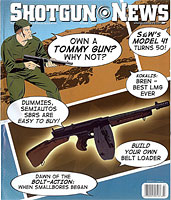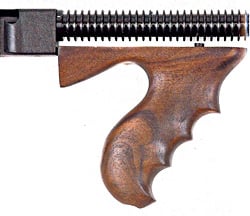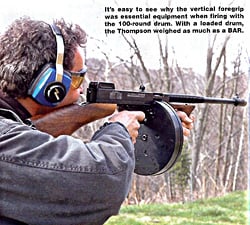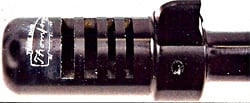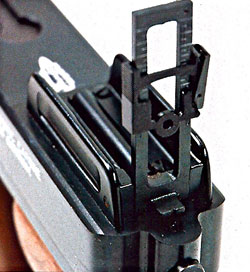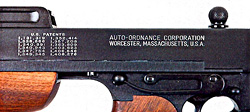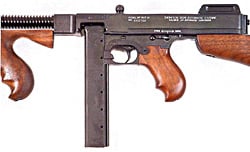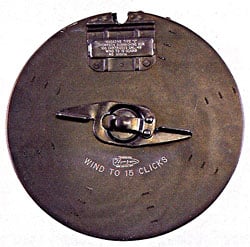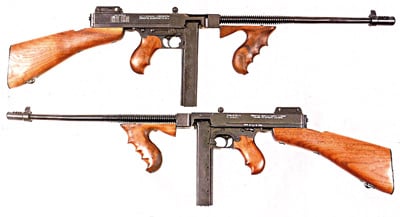 THE NEW SEMI-AUTO CARBINE FROM KAHR ARMS TAKES TOMMY GUN SHOOTING OUT OF THE LUXURY SUITE. AND THERE ARE SBR AND DUMMY GUNS, TOO, WITH LOOKS THAT DELIGHT.
THE NEW SEMI-AUTO CARBINE FROM KAHR ARMS TAKES TOMMY GUN SHOOTING OUT OF THE LUXURY SUITE. AND THERE ARE SBR AND DUMMY GUNS, TOO, WITH LOOKS THAT DELIGHT.
The Thompson Submachine Gun is arguably the most recognizable submachine gun is America, even 86 years after its initial introduction!
Although the Thompson is best known, aside from its gangster use, for its employment by U.S. and Allied forces during World War II, it was originally conceived during World War I. Many different military weapons were developed during the First World War all for one purpose … forward movement our of the trenches.
An Army Ordnance Officer, John T. Thompson, conceived the American version of a submachine gun, although the original concept originated in Europe. To design his submachine gun, dubbed a “trench broom” for sweeping the enemy from the trenches, Thompson enlisted the help of several talented individuals, including Theodore Eickhoff and Oscar Payne.
Although the resulting submachine gun was named after John T. Thompson, it was largely the efforts of Payne and Eickhoff that created it.
In 1921, John Thompson’s Auto-Ordnance Corporation signed an agreement with Colt’s Patent Fire Arms Manufacturing Co. for the actual manufacture of the Thompson. This was subcontracted to Colt because the Auto-Ordnance Corporation, which developed the gun, did not have any manufacturing capabilities.
The very first production run of the Thompson submachine gun only ran from 1921 to 1922. All of the original 1920s production Thompsons were manufactured by Colt under contract with the Auto-Ordnance Corp.
Only 15,000 Thompson Submachine Guns were manufactured by Colt, all as the Model of 1921. The original run of Thompson guns was manufactured to the very high commercial standards of the day.
The 1921 model had the famous Colt blue finish, and fine walnut stocks. The rear sight was adjustable for windage and elevation. The barrel of the Thompson featured radial cooling fins and a milled blade front sight. No compensators were originally fitted to the guns.
The actuator knob, fire mode selector and the safety levers were finely checkered. The original retail price of the 1921 model was $200, supplied with one 20-round box magazine. The first production Colt Thompson came off the assembly line in March of 1921.
By this time, World War I had ended and there was no demand for new arms. Sales of the Thompson were extremely slow. It would take almost 20 years to sell all of the initial production lot. The $200 list price of the Thompson was quite a sum of money in the 1920s. The National Firearms Act of 1934, aimed at keeping the guns out of the hands of criminals, added an additional $200 transfer tax to the cost, effectively ending Thompson sales to the public.
THE ORIGINAL COLT 1927
SEMI-AUTOMATIC CARBINE
The original 1927 carbine model is one of the rarest variations of the early Colt Thompson Guns. The 1927 model, like the 1921AC, 1928 Navy Model and others, were created by altering off-the-shelf 1921 models. The 1927 model fired only as a semi-auto. The gun was created to offer a Thompson to law enforcement organizations who, for political reasons, did not want to arm their officers with a submachine gun.
The conversion was accomplished by redesigning a few internal parts. The full-auto markings were neatly milled out of the receiver and remarked to fit its new semiautomatic configuration. The 1927 model is still regarded as an NFA firearm because of its short barrel and submachine gun receiver. The 1927 model was available with or without the optional Cutts compensator installed.
After 1922, there was little manufacturing activity or subcontracting by the Auto-Ordnance Corporation until World War II broke out with the German invasion of Poland in 1939.
WORLD WAR II
In the year following the initial run of the Colt-made Thompson, the financially troubled Auto-Ordnance Corporation fell into the hands of businessman Russell Maguire. In the late 1930s, Maguire had anticipated a major war in Europe, and a demand for modern arms.
Maguire at first tried to interest Colt in another production run of the Thompson, but the Hartford manufacturer declined his offer. Maguire eventually negotiated with the Savage Arms Corp. of Utica, N.Y. to manufacture the Thompson. By 1941, Auto-Ordnance had opened its own facility in Bridgeport Conn., to assist Savage with the increasing wartime demand for Thompson submachine guns.
Despite the success of government sales by Auto-Ordnance from 1940 to 1945, when World War II ended, the company’s assets were boxed up and placed in storage, destined to become but a footnote in history. Reportedly, during the post-World War II years, the remaining assets of the Auto-Ordnance Corporation changed hands several times.
In 1951, George Numrich, president of the Numrich Arms Corp. of West Hurley, N.Y. purchased Auto-Ordnance’s remains. The Numrich Arms Corp. specialized in selling gun parts, and often bought up the remaining inventories of defunct gun manufacturers. Included in the sale were a large number of parts for the Thompson Submachine Gun.
The company was able to assemble a few operable Thompsons from the surplus GI parts. By 1961, it had run out of many of the essential parts needed and could no longer assemble any Thompsons.
NUMRICH ARMS CORPORATION
In 1974, after obtaining the approval of the Treasury Department’s Bureau of Alcohol, Tobacco and Firearms, Numrich Arms began manufacture of the Thompson. They manufactured both semiautomatic and full-auto versions of the Thompson 1928 model, under the Auto-Ordnance name.
The receivers, trigger frames, bolts and barrels were new, while the remainder of the parts on the early guns were GI surplus, made by Savage and other wartime contractors. As production of the West Hurley guns continued, many original parts became unavailable, thus forcing the company to manufacture whatever parts it needed to maintain production. In 1985, the company also began the manufacture of a select-fire M1 (M1A1) version.
The majority of the 1928-type semiautomatic and select-fire Thompsons manufactured by the West Hurley, N.Y. company were fitted with a compensator-equipped finned barrel, vertical foregrip and a replica of the adjustable rear sight. The West Hurley Thompsons were finished in a dull “brush” blue color.
There were also special commemorative versions of the 1928 Thompson, made in both select-fire and semiautomatic configurations. Some of these commemorative West Hurley guns were accepted by the BATF for inclusion on the Curio and Relics firearm list, the manufacture of the full-automatic guns ceased in May 1986, when the ban on the manufacture of automatic firearms was enacted.
The Thompson Submachine Gun remains very popular with collectors today. However, the mid fire-figure prices of the fine 1920 era Colt guns are similar to that of a luxury SUV. The World War II M1928 and M1-M1A1 models have also greatly escalated in value, comparable to a nicely equipped full-size sedan. Today’s market prices place a Thompson well out of the reach of all but the most affluent collectors. However there is an alternative … a semiautomatic-only replica.
SEMI-AUTOMATIC THOMPSONS
In addition to the full-automatic Thompsons, Auto-Ordnance, West Hurley manufactured a number of semi-automatic versions of the Thompson. Mechanically, the semi-auto guns were quite different from the full-auto guns, firing from a closed bolt and having longer barrels, to comply with Federal requirements.
Manufacture of a semi-auto version of the 1928 model, designated as the 1927A1, began in 1975. A new 1927 A-1C model with an aluminum alloy receiver and trigger frame was introduced in 1980. These Thompsons had the suffix LW for Light-Weight on the serial number. There was also a 1927A5 “pistol” variation. These guns had no buttstock, and were fitted with a short 13.5-inch barrel. Production of the 1927A5 “pistol” ended when the gun was included in the 1994 assault weapons ban.
First introduced in 1985 was a semi-automatic-only version of the M1. These guns are identified by their long 16.5-inch barrels. Although the outward appearance of the semi-automatic-only M1 Thompson is similar to a full-auto version, they are quite different mechanically.
There had been quite a few reliability and quality-control issues reported with the West Hurley-manufactured Thompsons. Some of issues included cast aluminum components and pop rivets to secure the rear sights. The barrel compensators were held in place by a thread-locking material. The compensators and sometimes even the barrels worked loose after a time.
In February of 1999 another chapter in the Auto-Ordnance saga was written, when the company once again changed hands. Kahr Arms of Blauvalt, N.Y., purchased the company, manufacturing rights and tooling. Kahr is currently offering several models of the Thompson carbine in a semi-automatic-only configuration.
Kahr Arms has worked hard to improve both the quality and reliability of their products. Their Thompson carbines are made on modern machinery using CNC technology.
New for 2007 is the Kahr 1927A-1 cal. .45 semiautomatic deluxe carbine. Designated as the T1B model in the catalog, Kahr’s latest carbine has a number of improvements and innovations that make it worthy of attention.
The frame and receiver are both machined from solid steel. The wood is fine American walnut. The removable buttstock is the same design as the original Thompsons, and the stock hardware is all manufactured from steel. The front and rear grips have been redesigned and no longer have the unsightly “slab sided” design seen on many West Hurley manufactured guns.
The rear sight base is manufactured from steel and secured to the receiver by machine screws, not pop rivets. The sight ladder and sight aperture are identical to those found on the M1917 Enfield rifle. The receiver markings are nicely struck and are similar to those found on the World War II guns.
The flat black finish is also reminiscent of World War II production. The barrel is 16.5 inches in length as required by law, and is finished in a dull blue like the originals were. The Cutts-style compensator is also blued and is marked with the Thompson “bullet” logo, the compensator is now secured to the barrel with a crosspin. The redesigned cocking handle safety-fire selector are blued and nicely checkered.
The overall length is 41 inches with the buttstock assembly installed. The unloaded weight is a hefty 13 pounds. The carbine is shipped with one 30-round box magazine. The box magazines are refurbished GI surplus reconfigured to function in the semiautomatic carbines. The Kahr carbine comes with a one-year factory limited warranty.
There are a number of options available for the 1927A-1 carbine including extra 30-round box magazines, and the classic drum magazines in 10, 50 and 100-round configurations. For storage or transporting there are replica FBI hardcases, “violin” cases and a “Tommy Gun” padded rifle case available. All Kahr Thompson carbines are .45 ACP cal.
The final step in our evaluation of the new Kahr carbine was the test firing. The weight and barrel length of the .45 cal. carbine results in a low felt recoil and superb accuracy for a pistol caliber long gun.
Those more familiar with the operation of the open-bolt Thompson submachine gun will find cocking the carbine requires more effort, and the distance the cocking handle travels is less. Additionally after cocking, the bolt returns to a forward, closed position.
The first round of testing was done with the 30-round box magazine. At first the carbine was fired slowly taking careful aim, there were no malfunctions, the magazine was reloaded and fired as quickly as the trigger could be pulled, again no malfunctions.
Next the 100-round new manufacture Kahr drum magazine, serial No.000656 was placed in the gun. The loaded 100-round magazine was heavy, weighing 8 pounds, 4 ounces. To place a drum magazine into a Thompson the bolt must be locked in a rearward position, (caution make sure the safety is in the on position).
With a drum in place, the bolt does not remain rearward after the last shot. The “third hand” supplied with the drum was used to hold the bolt rearward, making drum removal easy.
Together, the loaded 100-round drum and the 13-pound carbine were quite heavy! The drum was tested by firing in slow single shots and rapid-fire. I am pleased to report that the drum performed flawlessly. Next a 50-round drum magazine was placed into the carbine, again with no malfunctions. The only problem encountered during the test was rear sight retaining screws worked loose.
ACCURACY AND VELOCITY
Accuracy of the Kahr Thompson was very good for a pistol caliber carbine, despite the gun’s heavy 8.5-pound trigger pull. Velocity was measured with a Pact chronograph. Ambient temperature was unseasonably cool 39°F. There was a slight intermittent crosswind on the day of the test that may have affected accuracy.
The carbine was fired from a bench rest at a range of 50 yards. The smallest group that could be achieved under the test conditions was 2.5 inches, the largest group was 3.7 inches with an overall average of 3.1 inches.
For the firing test several types of caliber .45 ACP ammunition were used: Wolf Gold, Wolf steel case, Fiocchi, Winchester (White Box) and American Eagle (Federal). All fed and functioned in the carbine, including the Wolf Gold 185-grain hollow-points. The velocity from the 16.5-inch barrel ranged from 878 fps to a high of 930 fps.
There are several other models of the Kahr Thompson carbines available.
THOMPON1927A-1 DELUXE SEMI-AUTO
This model is similar to the 1927A-1 model, tested having a 16.5-inch finned barrel, Cutts compensator and vertical foregrip. The primary difference between this model and the one evaluated is that this one has a non removable M1 style buttstock.
THOMPSON 1927A-1 COMMAND MODEL T1-C
This model has the same feature as the 1927A-1 variation above except the wood stock and horizontal foregrip are have a durable black finish. Included is a 30-round magazine and a black nylon sling.
THOMPSON M1 SEMI-AUTO
This is Kahr Arms’ military M1 Thompson carbine, styled after the famous M1 and M1A1 Thompson submachine guns fielded during World War II. The barrel is 16.5 inches in length and lacks the cooling fins and muzzle compensator featured on the 1927 series. The rear sight is a military fixed aperture type with protective side ears. The front sight is a blade style.
The cocking handle is located on the right side of the receiver. The walnut stock is a fixed M1 type, the foregrip is horizontal. The overall length is 38 inches. The gun is shipped with one 30-round box magazine. The M1 series, like its original military counterpart, is not designed to accept drum magazines.
THOMPSON M1-C LIGHTWEIGHT SEMI-AUTO
This is the lightweight version of the semi-auto M1, weighing only 8-pounds unloaded. The weight reduction was achieved by the use of an aluminum receiver. Other features are the same as the M1 model above.
SHORT BARREL RIFLES
Recently, semi-automatic carbines with short 10.5-inch barrels, like the original submachine guns, have become quite popular with enthusiasts. However, the installation of a short barrel on a semiautomatic carbine requires prior approval and registration with NFA Branch of the Bureau of Alcohol, Tobacco, Firearms and Explosives. Possession of an unregistered short barrel rifle (SBR) is a felony.
Kahr Arms offers factory short-barrel versions of most of their carbines. These short-barreled versions require a $200 Federal transfer tax and must be shipped to a qualified dealer in the customer’s home state. Kahr also offers smooth and finned 10.5-inch replacement barrels for use on properly registered guns.
THOMPSON SBR MODEL T1SB
For those that desire the look of the original configuration, this model is the same as the M1 and 1927A-1 models described earlier, but is fitted with a short 10.5-inch finned barrel, with compensator. This model requires registration and approval by the NFA Branch of the Bureau of Alcohol, Tobacco and Firearms and a $200 transfer fee. Some states prohibit sale or transfer of short barrel rifles (SBR).
DUMMY GUNS
Kahr also supplies dummy Thompsons, and these are just the thing for display in the home without the bother of federal paperwork. The cover gun is a dummy with authentic 10.5-inch barrel and original stock and fore-end. If you can’t afford an SBR or state laws prevent it, a dummy mat be a viable choice for you.

